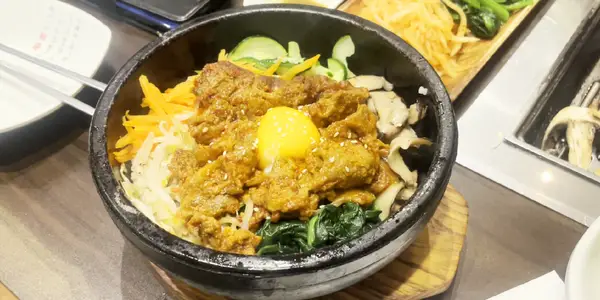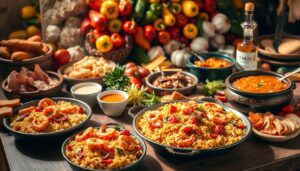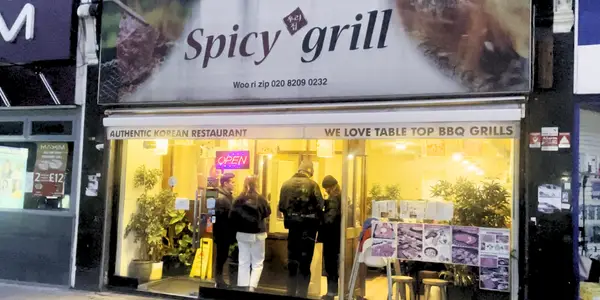The portions are massive and unless you were starving and had not eaten for a week I would not recommend ordering the house special for yourself, although you can take away anything left over it’s just not the same reheated the next day. To be honest I wish I had asked for the meat to be spiced up a little as I did find it lacking in flavor but that’s just me, for the health conscious eaters it would be perfect with the lettuce leaves, beansprouts, and kimchi salad that accompany this dish.

How would you describe Korean food?
The best way to describe Korean food is a vibrant and diverse cuisine that reflects the country’s unique geography, climate, and cultural history. It is characterized by its bold flavors, colorful presentation, and the use of a wide variety of ingredients, ranging from seafood and meat to vegetables, grains, and spices.
One of the defining features of Korean food is its emphasis on fermentation, which is used to create a range of flavorful and nutritious dishes such as kimchi, a spicy pickled vegetable dish that is a staple of the Korean diet. Other fermented foods include doenjang (soybean paste), gochujang (red pepper paste), and makgeolli (a milky, fermented rice wine).

Korean cuisine also features a range of soups, stews, and hotpots, which are typically hearty and spicy, and often served with rice and a variety of side dishes (known as banchan). Some popular dishes include bulgogi (grilled marinated beef), bibimbap (a rice bowl with various toppings), and samgyeopsal (grilled pork belly).
Seafood is also a significant component of Korean cuisine, with many coastal regions offering a variety of fresh fish and shellfish dishes, including raw fish (Yahweh) and spicy seafood stews (jjigae).
In summary, Korean food is a delicious and diverse cuisine that incorporates a range of flavors, textures, and ingredients. Its emphasis on fermentation, soups, stews, and seafood makes it a unique and exciting culinary experience that is well worth exploring.
What is a Korean BBQ grill called?
Korean BBQ is a popular dining experience that involves grilling various types of meats, seafood, and vegetables on a tabletop grill. The grill itself is typically a large, flat surface that is heated by charcoal or gas, and it is designed to allow diners to cook their food directly at the table.

The Korean BBQ grill is known as a “gogi-gu-i” (고기구이) in Korean, which literally translates to “meat roast.” It is a central part of the Korean BBQ experience, and it is often the focal point of the dining table.
The Gogi-gu-i is typically made from cast iron or stainless steel, and it is designed to be heated to high temperatures to quickly cook the meat and seafood. Some gogi-gu-i grills also have grooves or ridges on the surface, which help to drain excess fat and enhance the flavor of the food.
In addition to the standard gogi-gu-i grill, there are also specialized grills for specific dishes, such as galbi-gu-i (grilled short ribs), samgyeopsal-gu-i (grilled pork belly), and dak-galbi-gu-i (grilled spicy chicken).

Overall, the gogi-gu-i is an essential element of the Korean BBQ experience, and it is a fun and interactive way to enjoy a meal with friends and family.
Is traditional Korean food spicy?
Yes, Korean food is known for being spicy, but not all Korean dishes are spicy. The level of spiciness can vary from mild to extremely spicy, depending on the dish and the individual’s preference. The use of chili peppers is common in many Korean dishes, especially in stews, soups, and sauces, which are often served with rice and other side dishes.
One of the most well-known spicy Korean dishes is kimchi, which is a fermented cabbage dish that is seasoned with chili pepper flakes, garlic, ginger, and other spices. It is a staple of the Korean diet and is served with almost every meal.
Some of our articles may contain affiliate links, which means I earn a small commission at no extra cost to you but it does help me with the running costs. As an amazon associate, I will earn commissions on purchases but this does not affect my reviews on products or services.
Another popular spicy dish is bibimbap, a rice bowl topped with various vegetables, meat, and a spicy red pepper paste called gochujang. Other spicy dishes include tteokbokki (spicy rice cake), jjimdak (spicy braised chicken), and buldak (spicy stir-fried chicken).
However, not all Korean dishes are spicy. Some dishes, such as galbi (grilled beef short ribs), bulgogi (grilled marinated beef), and mandu (dumplings) are not typically spicy. Additionally, many Korean side dishes, known as banchan, are not spicy and are meant to balance out the flavors of the main dish.
Overall, while Korean food is known for being spicy, it is not always the case, and there are many non-spicy Korean dishes that are equally delicious.
- 10 Iconic Spanish Dishes You Have to Experience

- Electric Bikes and UK Public Highway Laws: Your Guide

- Female Chefs Reveal Why They Wear Menstrual Pants on the Job

This post may contain affiliate links where I get a commission on qualifying purchases at no extra cost to you.

